Messier 63
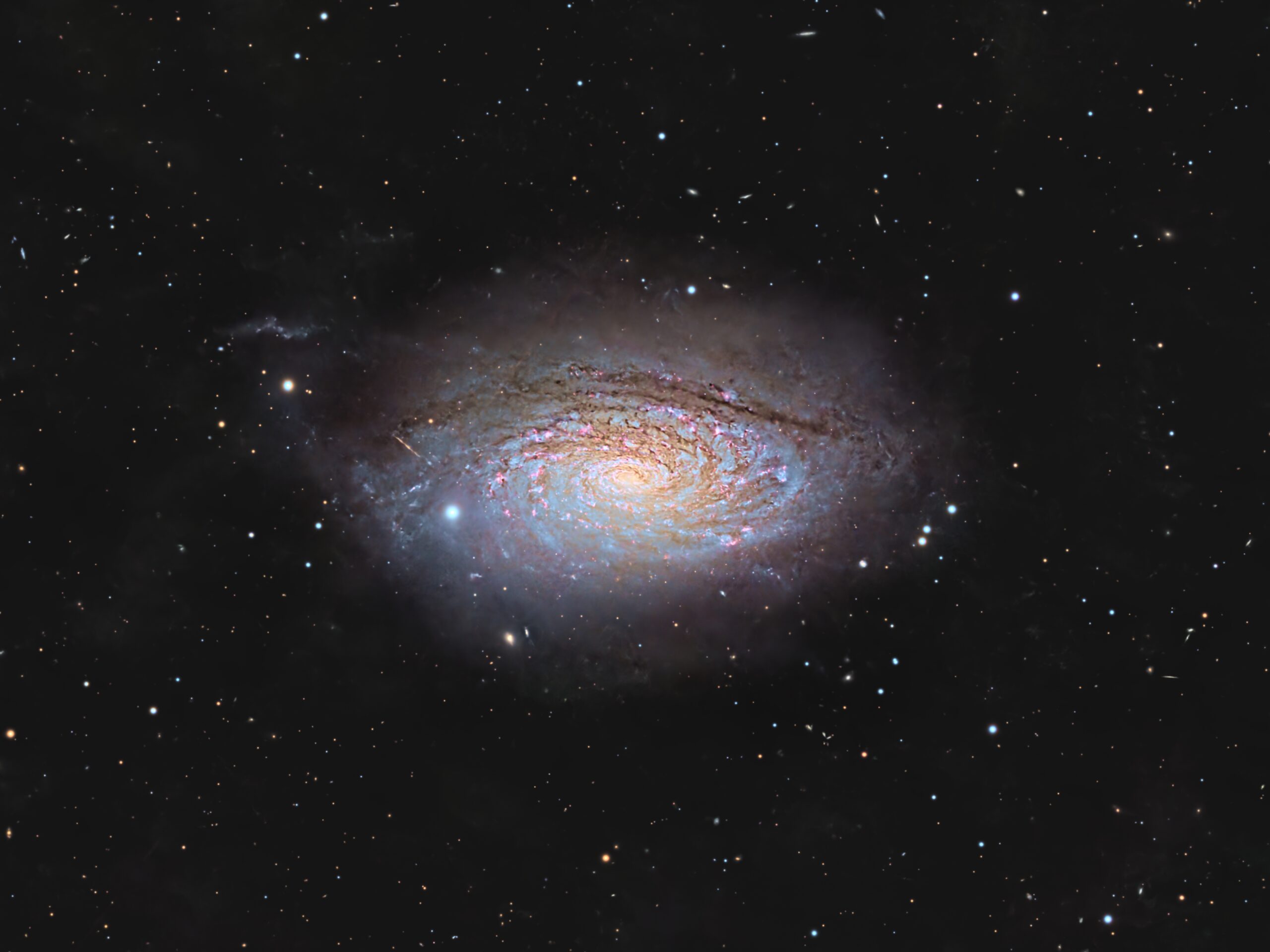 Click image for full size version
Click image for full size version
May 8, 2025
Messier 63 (M63) is also called the Sunflower Galaxy. Looking at the mottling it’s easy to see why. It belongs to the M51 Galaxy Group. There are many pink emission nebulae in M63; these structures are akin to our own galaxy’s Orion Nebula. In spite of its vast distance (25 – 30 million light years), M63 covers more than 1/3 of the Moon’s width, speaking to its immense size of more than 100,000 years across. This galaxy is known to have a faint tidal stream which is visible in this image, especially at left-centre of the image. It is thought to be due to interactions with other galaxies.
Tekkies:
Acquisition, focusing, and control of Paramount MX mount with N.I.N.A., TheSkyX and PHD2. Primalucelab low-profile 2″ Essato focuser and ARCO rotator. Guiding with PHD2. Equipment control with PrimaLuce Labs Eagle 4 Pro computer. Flats taken using a Primalucelab Giotto 430 mm flat panel. All pre-processing and processing in PixInsight. Acquired from my SkyShed in Guelph. Data acquired under a new to first quarter Moon with average or better transparency and and below average seeing between April 17 – 28, 2025.
Celestron 14″ EDGE HD telescope at f/11 (3,912 mm focal length) and QHY600M camera binned 2×2 with Optolong filters.
43 x 5m Red = 3hr 35m
37 x 5m Green = 3hr 05m
39 x 5m Blue = 3hr 15m
39 x 5m and 1 x 2m Ha = 3hr 17m
Total: 13hr 12m
Preprocessing: The WeightedBatchPreProcessing script was used to perform calibration, cosmetic correction, weighting, registration, integration and Drizzle integration of all frames (1x drizzle, 0.9 Drop Shrink).
RGB and SynthL masters: A master RGB image was made from the Red, Green and Blue Drizzled masters using ChannelCombination in RGB mode. A synthetic luminance (SynthL) master was made from all four masters using ImageIntegration with weighting by SNR.
Gradient Removal: DynamicBackgroundExtraction was applied to the SynthL, RGB and Ha masters.
Colour Calibration: BlurXterminator was applied to the RGB master with Correct Only selected, followed by ColorCalibration.
Deconvolution: BlurXterminator was applied to the RGB, SynthL, and Ha masters with Automatic psf , star sharpening set to 0.5, and non-stellar set to 0.9.
Linear Noise Reduction: NoiseXterminator was applied to the RGB, SynthL, and Ha masters with settings Amount=0.9 and Detail=0.25.
Ha Continuum Subtraction: The ContinuumSubtraction script, by Jurgen Terpe, was used to remove continuum emissions from the Ha master using the red channel of the RGB master as the continuum reference image.
Stretching: HistogramTransformation was applied to make a pleasing image from the RGB, SynthL, and Ha masters. Approximate background level after stretch was 0.1 for SynthL and 0.08 for the Ha and RGB masters.
Nonlinear Processing
Luminance-RGB addition: LRGBCombination was applied to replace the lightness of the RGB image with the Luminance master.
Star Removal and processing: StarXterminator was used to remove the stars from the LRGB and Ha masters with Unscreen checked. The Ha stars were discarded. Colour was increased in the LRGB stars-only image by applying Curves saturation through a star mask.
Initial Saturation Boost: CurvesTransformation’s saturation tool was used to boost colour in the galaxies in the starless LRGB image using a range mask made with RangeSelection to protect the background.
H-alpha Blending: The contiuum-subtracted Ha was added to the LRGB image using Jurgen Terpe’s CombineHaWithRGB script.
Nonlinear Noise Reduction: NoiseXterminator was applied to the HaLRGB image with settings Amount=0.9 and Iterations=5. SCNR was applied (Green; average neutral, 60%).
Contrast Enhancement: Jergen Terpe’s CreateHDRImage script was applied to compress the dynamic range of the galaxy slightly. LocalHistogramEqualization was then applied three times. A Contrast Limit of 1.5 and 1 iteration was used for each application (scale 40, strength 0.25, scale 140, strength 0.25, and scale 300, strength 0.1). DarkStructureEnhance was applied with default settings except amount=0.15.
Sharpening: MultiscaleMedianTransform was used to sharpen Layers 1 – 5 with strengths of 0.03, 0.03, 0.03, 0.04, and 0.01, respectively.
Star Restoration: Stars were added back into the image using the PixelMath expression combine(starless, stars_only, op_screen())
Final Steps: Background, galaxy, and star brightness, contrast, and saturation were adjusted in several iterations using CurvesTransformation with masks as required. ICCProfileTransformation (sRGB IEC61966-2.1; Relative Colorimetric with black point compensation) was applied prior to saving as a jpg. The finder chart was made using the FindingChart process.

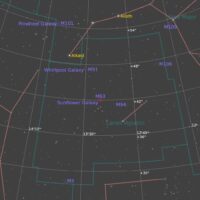
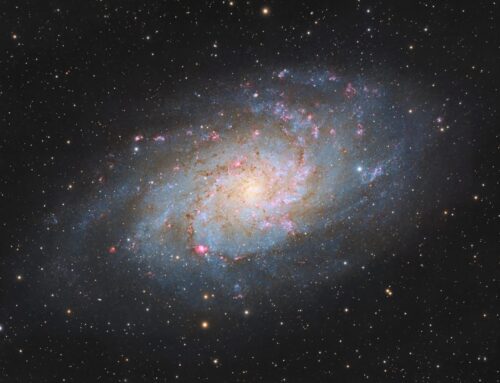

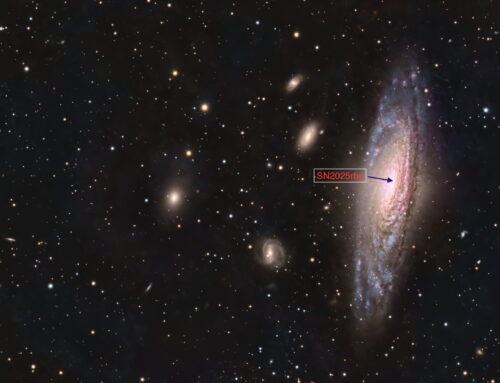
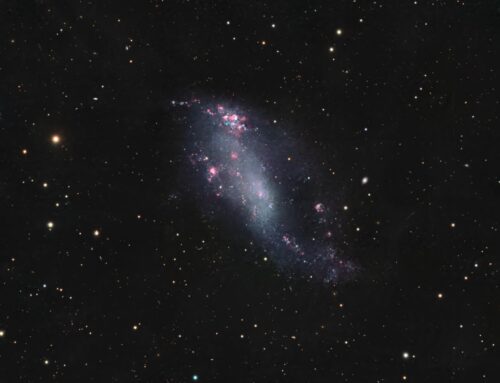
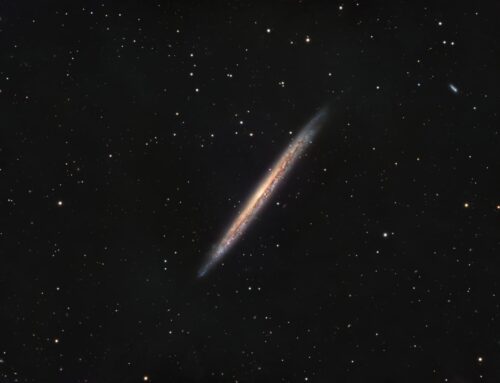
Nice!
Thanks David!
Great shot Ron! Love your posts.
SG